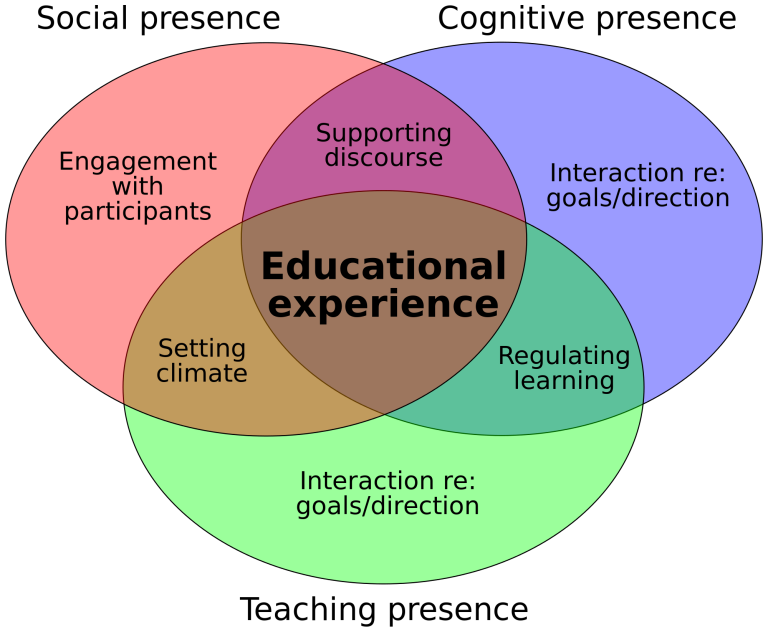During the orientation process for estudents, one of the most valuable outcomes is the development of a proper academic community. Students will be much more comfortable contributing to curriculum activities if they feel comfortable sharing with the staff and other students studying with them. We’ve seen this with pstudents too, but the effect is much more pronounced with estudents given their physical separation from their cohort.
This inclusion is a key aspect of learning through an online delivery. “The Internet encourages ideological cocooning” (Garrison, 2014) – the very concept of being isolated behind a computer screen acts as a barrier to the ability of the estudent to be challenged in their (in this case educational) beliefs and ideas. By building a solid academic community, we not only provide a more comfortable and supportive educational environment, but also more opportunity for community members to challenge one another on their expectations, opinions and thoughts, which ultimately leads to a more thoughtful and focused learning experience.
I’ve been using the term “academic community” up until now, but this idea is known in academic circles as a “community of inquiry”. It is not simply the case that putting together a group of academics (whether teachers or learners, or a mixture of both) generates this form of supportive and challenging community, but rather that the community is developed as its members engage in “deep and meaningful learning experiences” (Garrison, 2014). In other words, the members of a community of inquiry need to be actively engaging in the act of learning, be that through curriculum-based activity or through separate discussion and social interaction.
Applying this to orientation can be critical in smoothing the estudent’s entry into their programme of studies. (Leading on from my discussion on the differences between orientation and induction last time, I’m not going to look closely at induction here, as the development of this sort of community is difficult within the short time-frame normally associated with it). When trying to orient our students through their first semester, we can offer certain amounts of guidance and support, particularly around those times we believe they will be needed. But if we have generated a strong community of inquiry, a lot of that knowledge can be built upon (and indeed challenged) by our students as they discover the need. We know how individual students can have vastly different requirements and expectations, so allowing them to develop within their own timeframes and through their own perceived necessities can strengthen both the individual learner and the group as a whole.

As we can see from the diagrammatic representation of a community of inquiry above, the act of inquiry itself (represented here by cognitive presence) is only one aspect that needs to be present to deliver a full educational experience. The presence of both teaching and social elements is also critical. To some degree, the element highlighted as “Setting climate” is where we would envisage our induction process to sit, but we would hope that the orientation process would progress the estudents into the supporting discourse part of the diagram. By engaging with other participants (some of whom could still be staff) while cognitively engaging with the tasks at hand, we can see the orientation process developing our learners ability to discuss and learn in a manner independent of their academic leadership, while still part of a learning community. When you then factor in the taught curriculum, which initially would fall under “regulating learning” (although hopefully will not stay there for long!), we can see how our full educational experience can finally be realised.
Hopefully this shows further the vital role that good induction and orientation can play in developing our learners, but (without wanting to seem like a broken record) not in a silo. Development of taught curriculum, induction and orientation should be a tightly connected process between our academics and other supporting staff if we want to properly develop our estudents (and indeed our pstudents) into effective learners and members of their own community of inquiry.
Next time we are going to tie in with an ongoing activity on the BOE course, looking at the online social presence and how that might affect, and be incorporated into, the orientation process.
References
Garrison, D 2014, ‘Community of inquiry’, in D Coghlan, & M Brydon-Miller (eds), The SAGE encyclopedia of action research, vol. 3, SAGE Publications Ltd, London, pp. 148-51, viewed 3 March 2016, doi: http://dx.doi.org.ezproxy.napier.ac.uk/10.4135/9781446294406.n55.
Image licensing
Community of Inquiry diagram courtesy of Wikipedia user Matbury licenced under CC BY-SA 3.0
Featured image courtesy of Wikipedia user Eihpossophie licensed under CC BY-SA 3.0

An interesting treatment of Community of Inquiry, Duncan, and good to see that you are getting to grips with the complexities of how each of the dimensions of the model interact with one another. I was interested that you had labelled the intersection between cognitive and teaching presence as “regulating learning”. I see from the paper that the Unit 3 student-led seminar team are using (http://cde.athabascau.ca/coi_site/documents/Garrison_Anderson_Archer_Critical_Inquiry_model.pdf) that that intersection is labelled “selecting content”. I’ve always thought that “selecting content” didn’t quite describe what was happening between cognitive and teaching presence, and I wonder what your thoughts are on both those phrases.
Looking forward to hearing your thoughts.